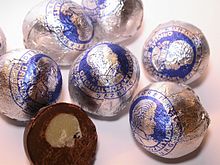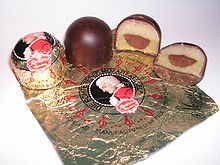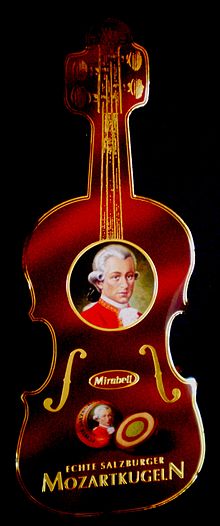- Mozartkugel
-
The Mozartkugel (English: Mozart ball), originally known as the “Mozartbonbon”, was created by the Salzburg confectioner, Paul Fürst, in 1890 and named after Wolfgang Amadeus Mozart.
The confectionery Fürst still produces the original Salzburg Mozartkugeln by hand according to the original recipe and only sells them in its shops or over its website. As the Fürst confectionery does not own a trademark for Mozartkugeln, there are numerous imitation products, most of which are produced using industrial techniques.
Contents
The Original
The master confectioner, Paul Fürst, came to Salzburg in 1884 and opened his own shop at number 13, Brodgasse. He presented the Mozartbonbon for the first time in 1890, later producing and selling it in greater quantities as Mozartkugeln. Fürst’s achievement was the production of a perfectly rounded chocolate, with no flat areas. The production process used by the confectionery Fürst has not changed to this day.
Paul Fürst presented the Mozartkugel at a fair in Paris in 1905 and was awarded a gold medal for it.
Today, the confectionery Fürst sells the original Salzburg Mozartkugeln exclusively in its four shops in Salzburg (at the Old Market, with branches in the Ritzerbogen, the Getreidegasse and near the Castle Mirabell), and via a direct service, but not in other shops. Mozartkugeln can be bought from the confectionery Fürst individually and in packages of several pieces.
Original recipe
The “Original Salzburg Mozartkugeln” are still produced manually by the confectionery Fürst according to the original recipe and using the original technique: First, a ball of green pistachio marzipan covered in a layer of nougat is produced. This ball is then placed on a small wooden stick and dunked in a dark chocolate coating. Next, the stick is placed vertically, with the ball at the top, on a platform to allow the chocolate to cool off and harden. Finally, the stick is removed; the hole that it leaves behind is filled with chocolate coating, and the ball is wrapped in blue-silver tin foil by hand. According to the Fürst company, their employees produce approximately 1.4 million Mozartkugeln by hand using this technique every year. In the firm’s air-conditioned salerooms, the balls remain fresh for about eight weeks.
Prizes
The specialist magazine, Der Feinschmecker (English: The Gastronome), gave the original Salzburg Mozartkugel first place in a comparison test of different Mozartkugeln in its January 2006 edition. It was remarked that the original Salzburg Mozartkugel is handmade and that it has a nougat taste with a note of slightly bitter pistachio marzipan. The original Salzburg Mozartkugel was awarded a gold medal at the second international truffle competition during the confectionery fair ÖKONDA in Wels in September 2005.
Rights to the name
The existence of numerous imitation Mozartkugeln finally led Paul Fürst’s descendants to initiate a court process. At stake were the rights to the name, not the Mozartkugeln recipe itself. At first, the dispute concerned only confectionery producers in Salzburg, but later spread to include the competition from Germany. The result was an agreement which obliged Fürst’s competitors to use other names. The Mirabell firm, based in Grödig near Salzburg, chose the name, “Real Salzburg Mozartkugeln”. The Bavarian producer, Reber, opted for “Real Reber Mozartkugeln”. In 1996, a dispute between Fürst and a subsidiary of the Swiss food producer, Nestlé, which wanted to market “Original Austria Mozartkugeln”, was decided in the third instance. Only Fürst products may be called original Salzburg Mozartkugeln.[1]
Other producers that employ the original recipe
The confectionery Dallmann, located in St. Gilgen on the Wolfgangsee, produces Mozartkugeln by hand according to Fürst’s original recipe. Like those produced by the confectionery Fürst, they are wrapped in silver tin foil marked with blue print.
The confectionery Engljähringer, which has operated in the city of Salzburg since 1948, also produces Mozartkugeln by hand using the original recipe. They are sold in cardboard boxes and are available at Salzburg’s University Square at the Engljähringer market stall. Handmade Mozartkugeln are not produced en masse using industrial techniques, whereby hollow Mozartkugeln are created and then filled. Engljähringer Mozartkugeln are produced by “wuzeln” (a regional term in Austria meaning to turn or to roll) the pistachio marzipan, by covering it in nougat and finally by dunking it by hand in chocolate coating.
The confectionery Petrik, whose base of operations in the Getreidegasse, not too far from the house in which Mozart was born, produces Mozartkugeln using the same sound and traditional method. The confectionery took a top place in the 2006 Mozartkugel test carried out by the “We are Mozart” website.[2]
Industrially produced Mozartkugeln
Shortly after the presentation of the Mozartkugel in Paris, other Salzburg confectioners started to copy it due to its popularity. The newly developing sweet industry quickly began to produce this popular specialty too, as Fürst had not secured the rights to the name Mozartkugel.
The industrially produced Mozartkugeln do not use the original recipe, being based instead on variations of it. Furthermore, they are smaller than the original and are often flat on one side. The Mozartkugeln produced by the Mirabell company have a green, ring-shaped marzipan centre surrounded by light and dark nougat creme. Those produced by the German company Reber have a centre made of nougat, which is surrounded on one side by white marzipan, and on the other side by green marzipan. Moreover, they are flat on one side and not completely round. The Mozartkugeln produced by another German company, Lambertz, are also flat on one side, with a hazelnut and nougat centre surrounded by pistachio and almond marzipan and covered in a layer of dark chocolate. Both Mirabell and Reber emphasise that no preservatives, colouring or artificial aromas are used in their products.
The leading industrial producers of Mozartkugeln, Reber and Mirabell, are both based in the area of the Euregio Salzburg – Berchtesgadener Land – Traunstein.
Austria
The largest industrial producer of Mozartkugeln in Austria is the Mirabell company (Kraft Foods Austria), which is based in Grödig near Salzburg. According to its own figures[citation needed], Mirabell produces over 90 million Mozartkugeln per year and exports them to more than 30 countries. Mirabell claims[citation needed] to have produced a total of 1.5 billion Mozartkugeln since 1945. Other producers include the Viennese company Hofbauer, which produces varieties with milk chocolate and dark chocolate, and Manner, which has factories in Vienna, Wolkersdorf and Perg.
Germany
The worlds largest industrial producer of Mozartkugeln is the German company Reber Specialities, which has been active in Bad Reichenhall since 1938. According to Reber, its daily capacity is 500,000 Mozartkugeln, and it exports its products to 40 countries. Another German producer is the Confiserie Dreher. It is also located in Bad Reichenhall and has been producing Mozartkugeln since 1931. It claims to be the oldest German producer of Mozartkugeln. Dreher was bought in 2000 by the Halloren Chocolate Factory in Halle (Saale).[3] The Lambertz company, based in Aachen, also produces Mozartkugeln e.g. for discount supermarket chains like Aldi.
Dispute between Mirabell and Reber
At the end of the 1970s, a dispute arose between the Mozartkugeln producers Mirabell and Reber over the trademark. A provisional agreement was reached in 1981 between representatives of the Austrian and German governments, whereby only Austrian producers were to be allowed to use the label "Mozartkugeln". Reber protested against this agreement, and the EC-Commissioner in Brussels charged with deciding in the affair finally declared the agreement invalid.[4] This is why Reber may legitimately and continuously use his Genuine Reber Mozart-Kugeln trademark, though with a hyphen in-between.
Nonetheless, only Mirabell Mozartkugeln are allowed to be round. Other industrially produced Mozartkugeln must have one flat side.[5]
Other Fürst chocolates named after famous personalities
Besides the famous “Original Salzburger Mozartkugeln”, which is named after Wolfgang Amadeus Mozart, there are further chocolates that are named after famous personalities: the Bachwürfel (English: Bach cube) (Johann Sebastian Bach), Wolf-Dietrich-Block (Wolf Dietrich von Raitenau), Doppler Kon(Ef)fekt (Christian Doppler) and the Paris-Lodron-Truffle (Paris Graf von Lodron).
Trivia
In the winter and spring of 2006, 80 oversized polyester Mozartkugeln, each with a diameter of 1.6 metres, were placed in the old town of Salzburg. They had been designed by artists. In the night of the 27th of March, vandals removed one of these Mozartkugeln from the Franziskanergasse, where it had been bolted to the ground. The unknown vandals then rolled the Mozartkugel onto the street, causing damage worth around 7000 euro.[6]
The confectionery Dallmann in St. Gilgen offers a Mozartkugeln seminar. Participants graduate as Mozartkugeln specialists.[4]
Sources
- ^ Mozartkugeln: echt oder original?
- ^ Mozartkugeltest
- ^ Confiserie Dreher
- ^ a b http://web.archive.org/web/20070822055754/http://www2.t-online-business.de/dyn/c/67/81/84/6781842.html
- ^ Nur die Kugel rollt
- ^ derStandard.at
External links
- History of the Mozartkugel (in German)
- Café Konditorei Fürst Salzburg
- This article incorporates information from this version of the equivalent article on the German Wikipedia.
Categories:- Austrian cuisine
- Chocolate
- Wolfgang Amadeus Mozart in popular culture
- 1890 introductions
- Confectionery
Wikimedia Foundation. 2010.





